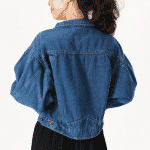Nowadays, denim is part of every wardrobe. Many people wear it in their daily routine. But do you know what denim means? Absolutely not. I am here to talk about it in detail so let’s start.
Denim means a firm, durable twilled fabric made of colored warp and white filling threads, usually cotton. It is a dark blue fabric commonly used to make durable workwear such as jeans and overalls. Blue jeans are known as denim in some places.
What is denim?
It’s a sturdy cotton fabric having a twill weave that creates a refined diagonal ribbing pattern. In denim, the weft strands go under 2, or more strands, as well as the warp yarns, seem to be more prominent on the very right side of the cotton twill cloth – which is warp-facing. Denim is distinguished from cotton duck and canvas, both of which are sturdy woven cotton fabrics, by the diagonal ribbing.
The Origin of the word “Denim.”
Denim gets its name from a French fabric called serge de Nimes,’ which became famous in the 1600s. Genoa, Italy, is renowned for a deep, durable blue cotton cloth referred to as ‘bleu de Gênes’ in the 17th and 18th centuries.
A large number of bleu de Gênes fabric was shipped to Nîmes, France, which was the European hub for ribbon makers and weavers. To reduce their reliance on Italian cloth manufacturers, Nîmes weavers started experimenting with creating their blue cloth that was equally durable and sturdy.
They actually developed the twill fabric, which is created using a diagonal parallel ribs pattern and two different threads: wool and raw silk. The weft yarn remained white, while the warp yarn was colored with indigo.
The cloth that resulted had two distinct sides. The dark blue side with the most visible weft yarn became the visible-facing side, while the soft-blue side with the most visible warp yarn became the back.
Due to its unique weaving technique, the cloth was highly durable and comparable to the Italian bleu de Gênes. However, the French cloth was soon given its own title:’serge, de Nîmes,’ abbreviated to ‘de Nîmes,’ which the Americans and English later shortened to the now-famous ‘denim.’
What does denim mean in jeans?
If we describe it in a sentence, Denim is a Potato while Jeans are French Fries.
Jeans are timeless garments worn by people of different ages all over the world. It has a broad appeal and a youthful, rugged appearance. Jeans were first introduced in the second half of the nineteenth century by Levi Strauss, like copper riveted cotton trousers. They have since evolved into a type of trouser seen across the wardrobes of most men and women worldwide.
Jeans are considered casual clothing worn by both men and women outside of work. Though today’s jeans come in a variety of overdyed colors, blue is the color that gives them their distinct identity.
Denim
The fabric that is being used to make jeans is known as denim. It’s a cotton twill fabric that’s 100 percent cotton and extremely comfortable. Denim is used to make shirts, jeans, purses, jackets, bags, and various other accessories for both men and women of different ages all over the world. However, the garment ‘jeans’ has given this fabric its own identity.
Denim fabric is woven with white cotton filling yarn and blue cotton warp yarn to create twill with diagonal running parallel lines. The fabric is so widely used in ready-to-wear garments and fashion accessories that it can now be found in any store that sells ready-to-wear clothing.
How Is Denim Made?
When cotton fibers are harvested and twisted into thread, the yarns are dyed. The most popular type of denim is indigo-dyed jeans, which come in a classic blue color. Cotton denim is woven on a projectile loom or a shuttle loom.
A shuttle loom is used to make selvedge denim. There are no breaks in the weft thread as it passes back and forth over the warp threads. As a result, the selvage edge is both smooth and durable.
Non-selvage denim is made on a projectile loom with only one weft thread woven across each row. As a result, the edge becomes more delicate and must be sewn to prevent fraying.
Denim can be black, right?
Yes! Denim can be black as it can be dyed very easily. However, nothing is ever straightforward. Denim comes in a variety of styles. Some denim is made of natural fibers, while others are made of synthetic materials. Denim is available in several colors, ranging from pure white to its polar opposite, black.
The fabric blend in your denim and the color you’re starting with will determine whether or not you can dye blue jeans.
How do you identify denim?
When it comes to identifying denim, there are types of denim wear, original, replica, and fake jeans.
Original products are made with the highest quality materials and are based on long-held designs. Replica jeans are made from company-owned designs, but they use less durable and structurally sound materials and techniques than the originals. Some replicas are created using a design from the company’s archives.
Fake jeans, also known as knock-offs, are made by a different company and imitate a well-known brand. Knock-offs are frequently of poor quality and contain obvious flaws. Many people don’t mind wearing fakes because they are inexpensive and well-made, especially in countries where fashion is valued more than name brands.
Stretch denim may contain polyester, but this will not affect the jeans’ durability. On the other hand, any other materials should be treated with caution. The stitching must be symmetrical and frayed-free. The higher the stitching quality, the more likely you will deal with authentic denim.
Conclusion:
So, this was all about what denim means, what it is, how to identify it, and more. I hope after reading this guide, you will know what denim actually means and how to identify it.






